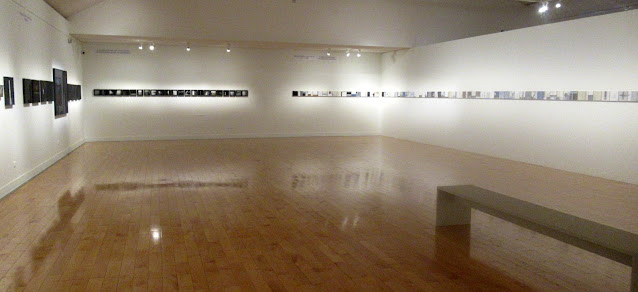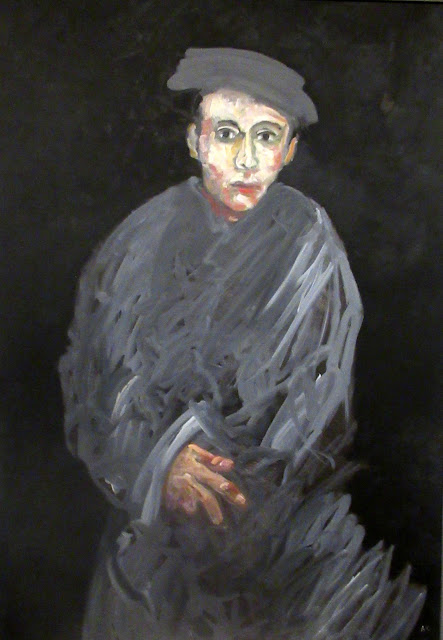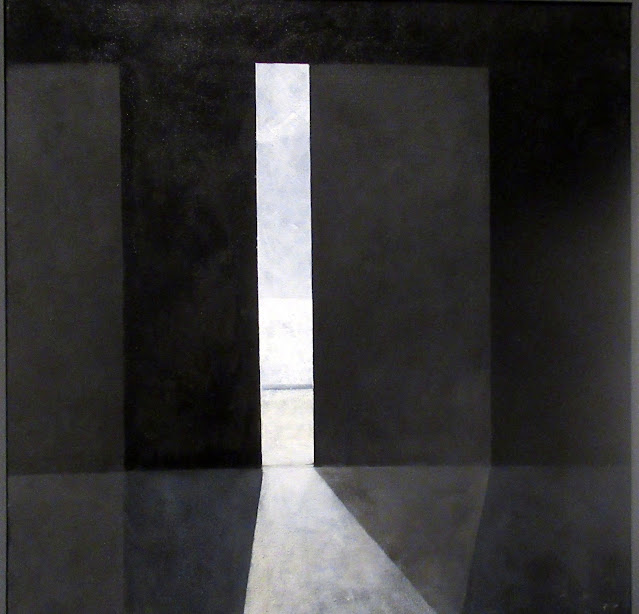George Hadjimichalis: a retrospective - 3: A Novel
This is the third post on this exhibition and I have reproduced the same introduction as I did in the two previous posts.
Hadjimichalis was born in Athens in 1954. In 1966 he took his first painting lessons. Since the summer of that year, painting became his main occupation. In 1971, without having finished school, he went to London, where he was accepted into the Department of Painting at the Hammersmith School of Art. In 1973 he was accepted by St. Martin's School of Art, on its adevanced study programme from which he graduated in 1975. In 1978 he returned to Greece.
Hadjimichalis' art is multifaceted. His works comprise large units, whose construction often requires research into archives and all sort of texts - a kjnd of reperage. To create a work, he regularly uses a range of different mediums, such as painting, video, photography, text, printouts, etc. Several units, which make up the body of his work, were shown in this exhibition for the first time.
There are normally four temporary exhibitions on at the museum, but this time, only this exhibition, as it was taking up all four galleries. It was huge. I am going to cover some of the parts of the exhibition in three posts.
The main thing to say about this exhibition though, is that we had fun. We looked, we wondered, we laughed, we waited with anticipation for the next bit, marvelling at how the artist's mind worked and what he had in store for us next. It was a fantastic experience.
* * *
The last part of the exhibition, entitled George Hadjimichalis - the Painter A.K. - A Novel, is an installation that consists of 265 small and medium-sized paintings, 29 photographs, a structure and a video, which comprise the retrospective exhibition of an imaginary painter. Adopting the practice of a novelist, Hadjimichalis envisions a fictional person and creates his artwork, telling a story.
It is a work open to multiple readings and includes a plethora of references and correlations. In this work, Hadjimichalis connects the personal to the collective, the experiential to fantasy, fiction to reality, identity to otherness, and the self to the Other. The work also contains an underlying autobiographical element, as the life of the imaginary painter inevitably meets that of the novel's creator. In this narrative piece, Hadjimichalis addresses issues such as the human body and the human soul, illness, loss, memory.
This is a novel that is not written in words but images, mostly painted but also photographic and moving (video). I have however, only included the paintings in this post. Hadjimichalis works as though writing a book or directing a film, using details from his own life for the script. As he has said himself, 'I take a subject and I narrate it to the viewer through my own experiences and means... Of course, I direct with different means to those used by a director. I'm a painter. As a painter, I construct images using various means and materials, as appropriate, to best serve my narrative'. In this project, the artist, as well as an author, director and painter, also functions as a curator, as he designs and sets up the painter A.K.'s retrospective exhibition. The work took approximately four years to make.
* * *
The Novel:
The painter A.K. was born in 1924 and died in the mid-1980s. From 1948 onwards, he lived in a first floor apartment at 51 Polyla Street, in the Kypriadou area of Athens. At some point, probably in 1976, he confined himself inside his home and never left again until he died (maybe he committed suicide).
The intense dark colours and the painting style allude to German Expressionism and artists like Edvard Munch, Chaim Soutine, Oskar Kokoschka, etc. This chapter also includes a series of night-time landscapes that capture a highly evocative atmosphere of mystery and darkness, which deeply engage the viewer.
The reason A.K. potrays a world of corruption, pain, sickness and worry is possibly related to the time in which he created these paintings. It was a calamitous time for Greece, a decade during which it suffered through Metaxa's dictatorship, the German occupation, and a civil war. As a young man living through such hard and tough times for the Greek nation, A.K. creates works that, albeit not depicting the events as such, nonetheless carry that prevailing sense of hardship and desperation. Beyond that hypothesis, however, we could also assume that A.K. was going through personal difficulties, possibly connected to psychological problems, or heath issues, his own or a loved one's. In these paintings, individual sufrering and misery meets collective misfortune and trial.
Chapter 2:
Chapter 3:
Chapter 4:
Chapter 5:
This final chapter begins in 1976 and ends with the death of the painter A.K., in the mid-80s. Those are the years when A.K. decides to seclude himself in his house, making a series of small scale paintings, acrylic on wood, one after another. In a true borderline state between neurosis and psychosis, he paints, obsessively and with extreme accuracy, details of his house, such as door knobs, handles, keyholes, tiles, pipes, switches, sinks, radiators, cracks, etc. as well as certain personal objects he finds scattered around the place.
A.K. focuses on details and creates close-up 'painting shots', striving for faithful representation and absolute perfection. What the painter seems to struggle with in these pieces is his need to hold on to the realistic element, in an attempt to stay in contact with reality.



















































No comments:
Post a Comment